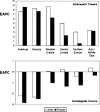Epidemiology, risk factors, and pathogenesis of cholangiocarcinoma
- PMID: 18773060
- PMCID: PMC2504381
- DOI: 10.1080/13651820801992641
Epidemiology, risk factors, and pathogenesis of cholangiocarcinoma
Abstract
Cholangiocarcinoma (CCA) is a fatal cancer of the biliary epithelium, arising either within the liver (intrahepatic, ICC) or in the extrahepatic bile ducts (extrahepatic ECC). Globally, CCA is the second most common primary hepatic malignancy. Several recent epidemiological studies have shown that the incidence and mortality rates of ICC are increasing. This review of the literature on the international epidemiological rates of CCA, both intra- and extrahepatic, explores possible explanations for the trends found. The possible role of epidemiological artifact in the findings is discussed and the known risk factors for CCA are summarized. These include primary sclerosing cholangitis, liver fluke infestation, congenital fibropolycystic liver, bile duct adenomas, and biliary papillomatosis, hepatolithiasis, chemical carcinogens such as nitrosamines, Thorotrast, chronic viral hepatitis, cirrhosis, chronic non-alcoholic liver disease and obesity. Potential pathways involved in the molecular pathogenesis of CCA are also summarized.
Keywords: Cholangiocarcinoma.
Figures


References
-
- Shaib , et al. The epidemiology of cholangiocarcinoma. Semin Liver Dis. 2004;24:115–25. - PubMed
-
- Khan , et al. Changing international trends in mortality rates for liver, biliary and pancreatic tumours. J Hepatol. 2002;37:806–13. - PubMed
-
- Patel T. Increasing incidence and mortality of primary intrahepatic cholangiocarcinoma in the United States. Hepatology. 2001;33:1353–7. - PubMed
LinkOut - more resources
Full Text Sources
Other Literature Sources

